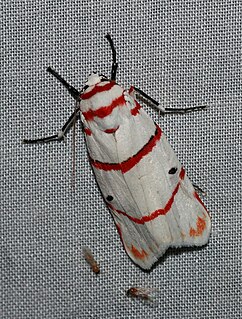
Cyana is a genus of moths in the family Erebidae. Species are well distributed in Africa, Madagascar, China, India, Sri Lanka, Myanmar, Sumatra, Java and Borneo. The genus was erected by Francis Walker in 1854.

Cyana malayensis is a moth of the family Erebidae. It is found in Peninsular Malaysia, Borneo and Palawan.
CYANA is a program for automated structure calculation of biological macromolecules on the basis of conformational constraints from nuclear magnetic resonance (NMR). The combination of automated nuclear Overhauser effect spectroscopy (NOESY) cross peak assignment, structure calculation with a fast torsion angle dynamics algorithm.

Cyana puella is a moth of the family Erebidae. It is found in the north-western Himalayas, Nepal, India, Sri Lanka, Madagascar, Kenya and Eritrea.

The Iberian magpie is a bird in the crow family. It is 31–35 cm long and similar in overall shape to the Eurasian magpie but is more slender with proportionately smaller legs and bill. It belongs to the genus Cyanopica.

Cyana effracta is a moth of the family Erebidae first described by Francis Walker in 1854. It is found in Nepal, the north-eastern Himalayas, Taiwan, China, Burma, Peninsular Malaysia, Sumatra and Borneo.

Cyana hamata is a moth of the family Erebidae first described by Francis Walker in 1854. It is found in Japan, China, Taiwan, Korea and Thailand.
Cyana africana is a moth of the family Erebidae. It was described by William Jacob Holland in 1893. It is found in Gabon.
Cyana basisticta is a moth of the family Erebidae. It was described by George Hampson in 1914. It is found in Ghana and Sierra Leone.
Cyana flammeostrigata is a moth in the family Erebidae. It was described by Timm Karisch in 2003. It is found in Cameroon, Equatorial Guinea, Kenya, Nigeria and Uganda.
Cyana fulvia is a moth of the family Erebidae. It was described by Carl Linnaeus in his 1758 10th edition of Systema Naturae. It is found in Sierra Leone.
Cyana paramargarethae is a moth of the family Erebidae. It was described by Timm Karisch and Ugo Dall'Asta in 2010. It is found in the Democratic Republic of the Congo and Rwanda.
Cyana pretoriae is a moth of the family Erebidae. It was described by William Lucas Distant in 1897. It is found in the Democratic Republic of the Congo, Kenya, Lesotho, Malawi, Mozambique, Somalia, South Africa, Tanzania, Uganda, Zambia and Zimbabwe.
Cyana rejecta is a moth of the family Erebidae. It was described by Francis Walker in 1854. It is found in the Democratic Republic of the Congo, Ethiopia, Kenya, Malawi, Sierra Leone, South Africa, Tanzania, Gambia and Uganda.
Cyana rubristriga is a moth of the family Erebidae. It was described by William Jacob Holland in 1893. It is found in the Central African Republic, the Democratic Republic of the Congo and Gabon.
Cyana rufifrons is a species of moth of the family Erebidae. It was described by Walter Rothschild in 1912. It is found on São Tomé Island.
Cyana tegyra is a moth of the family Erebidae. It was described by Herbert Druce in 1899. It is found on New Guinea.
Cyana torrida is a moth of the family Erebidae. It was described by William Jacob Holland in 1893. It is found in Equatorial Guinea.
Cyana ugandana is a moth of the family Erebidae. It was described by Strand in 1912. It is found in the Democratic Republic of Congo, Ethiopia, Kenya and Uganda.
The Nudariina are a subtribe of lichen moths in the family Erebidae. The taxon was described by Carl Julius Bernhard Börner in 1920.





